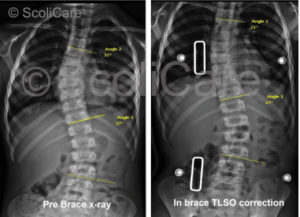Patient aged 7 years with scoliosis thoracic curve measured at 32 degrees and lumbar curve measured at 27 degrees.
Background
Patient presented to the Sydney Scoliosis Clinic, aged 7 years at the time on initial examination. This patient had been recommended and fitted with a traditional 3 point pressure hospital made TLSO.
This brace had achieved minimal in-brace correction – the thoracic curve had been reduced from 32 to 21 degrees. The lumbar curve remained the same in brace.

Treatment
The patient was recommended a customised 3D designed rigid brace. New in-brace x-rays show an improved in-brace correction in this brace compared to the hospital TLSO.
Results
Thoracic curve reduced to 13 degrees which was a correction of 19 degrees and 8 degrees better than the hospital brace. The lumbar curve reduced to 3 degrees which was a correction of 24 degrees. The hospital brace made NO improvement in the lumbar curve.
Discussion
The customised rigid brace created for this patient was not a traditional 3 point pressure brace. Instead the brace used a concept of spinal repositioning by over correcting the body posture and using specific 3D moulding to main the correction in the brace. As highlighted in Stokes review on bracing published in Bone Joint Journal. 2013 titled “The current status of bracing for patients with adolescent idiopathic scoliosis”. Stokes states that; “In conclusion…The Hueter–Volkmann principle holds true for bracing in AIS. If a brace does not correct a curve onapplication, then either the brace has not been designed, manufactured or fitted correctly, or the curve cannot be braced.”
This case demonstrates a clear difference in corrective effect on the same patient by two different braces. One of the braces had poor correction and most likely would have not stopped progression of the curve. The other had good correction and has a much high chance of stopping progression or improving the curve.
Conclusion
Not all braces are the same. In this case the 3D designed, customised rigid brace clearly showed a superior in-brace correction to the hospital manufactured brace for the same patient. Although this case has not reached its end point and treatment is ongoing, this case shows a rigid custom designed 3D scoliosis brace may achieve reduction in Cobb angle in similar cases.
NB: All cases are different and results may vary case to case. Our commitment is to recommend the most appropriate treatment based on the patient’s type and severity of scoliosis.
© ScoliCare & The ScoliCare Clinic Sydney
